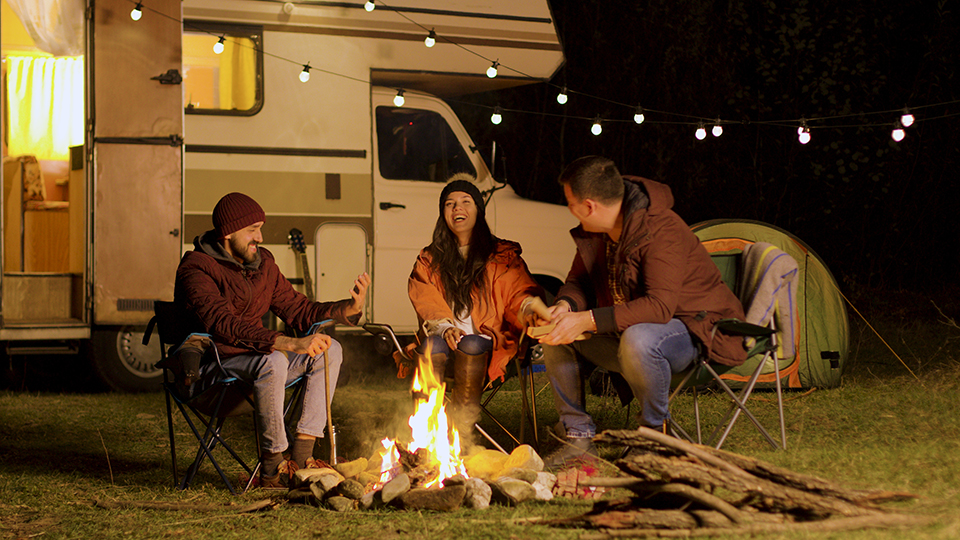Camping is one of the best ways to explore Texas during the summer. Whether you’re looking to vacation with your closest friends or bring the kids for a family bonding experience, a well-planned campout will allow you to explore the state’s natural beauty.
If you’re a beginner, Patten Title’s guide will show you all the ins and outs of how to plan for a great trip. More experienced campers will find the right spot to spend the weekend this summer.
Decide Your Camping Style
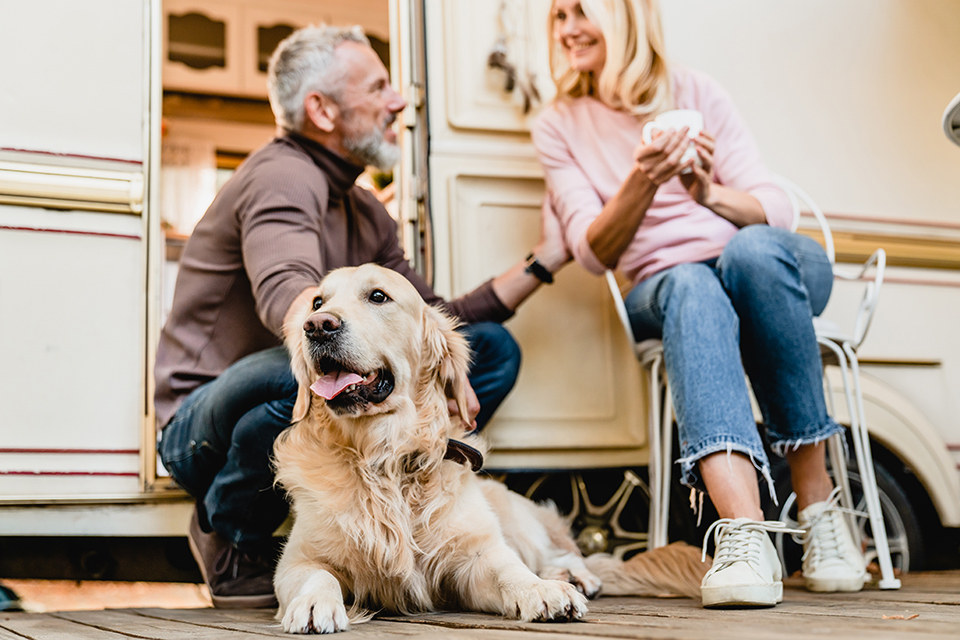
The first step to planning a great Texas campout is to decide your camping style. Your camping experience will be different if you decide to take a tent over a rented cabin.
Options are versatile in most places you can choose from, with many campgrounds accommodating multiple types of equipment. State parks, for instance, offer accommodations ranging from rustic tent sites to RV parking, cabin rentals, or new glamping opportunities.
How do you know your camping style? Ask yourself a few questions first.
First, decide who is going on the trip with you. If you’re taking babies or toddlers on their first camping, consider if you’d be better in a cabin where you’ll have more space for diaper changes. If this is a trip with your best friends, take a poll to find out how many have experience setting up a tent or if they have their own equipment.
Second, you’ll want to assess what kind of equipment you and your crew already have. If no one has a tent, decide if it’s more economical to purchase or rent a tent or consider renting a cabin.
Finally, know what you’ll do on this trip when you’re not camping. Will this be a vacation to hike, bike, fish, and enjoy other outdoor activities? Or will you be sightseeing, shopping, or attending a concert? Remembering that will help you decide how you’d prefer to sleep.
Know Your Equipment
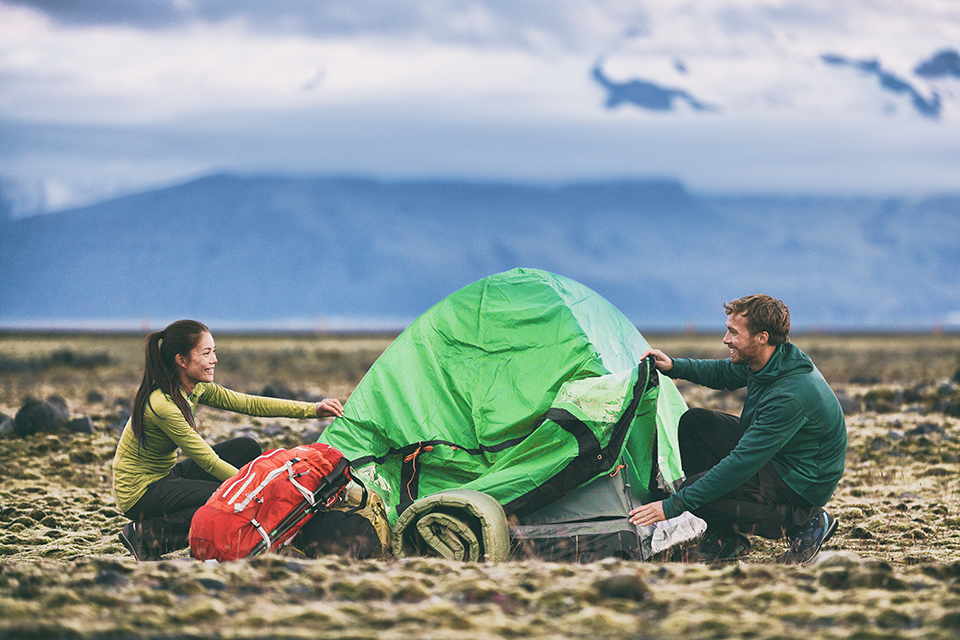
Having the right equipment is crucial to a successful camping trip. Make a list of what you need, what you have, and what you’ll need to upgrade before you hit the road.
Tents:
If you’ve elected to sleep in a tent, practice setting it up at least once. This way, you can check for missing pieces or repair any damage. The practice also ensures that everyone knows their role once you reach your campsite. One non-negotiable item for tent camping is a tarp. Your rain fly may not be enough to withstand a real Texas downpour, so a tarp will make sure that you don’t wake up to water dripping onto your sleeping bags.
Lighting & Power:
Everyone on the trip should bring their own flashlight or lantern. You could be “roughing it” without electricity in some cabin rentals, so having more than enough light is essential. While you might not have much Wi-Fi access at your campsite, you’ll want to keep a phone charged for emergencies. Be sure to pre-charge and pack a wireless battery charger (or two) for such an occasion. If you know you’ll have electricity access, bring an extension cord and a battery recharger for your flashlight batteries.
Luxury items:
No matter your camping style, there’s no shame in adding some extra opulence to your experience. Portable fans can help you beat the summer heat, and an inflatable mattress will make sleeping on the ground far more comfortable.
RVs & tent campers:
If you have recently purchased an RV or tent camper, or plan to rent one, take some time to get familiar with the features and components. Before setting out, you should be able to locate key features like slide-outs and understand how to use water and sewage hookups. Whether you are towing or driving your camper, practice parking and (if necessary) unhitching beforehand.
Pack the Essentials
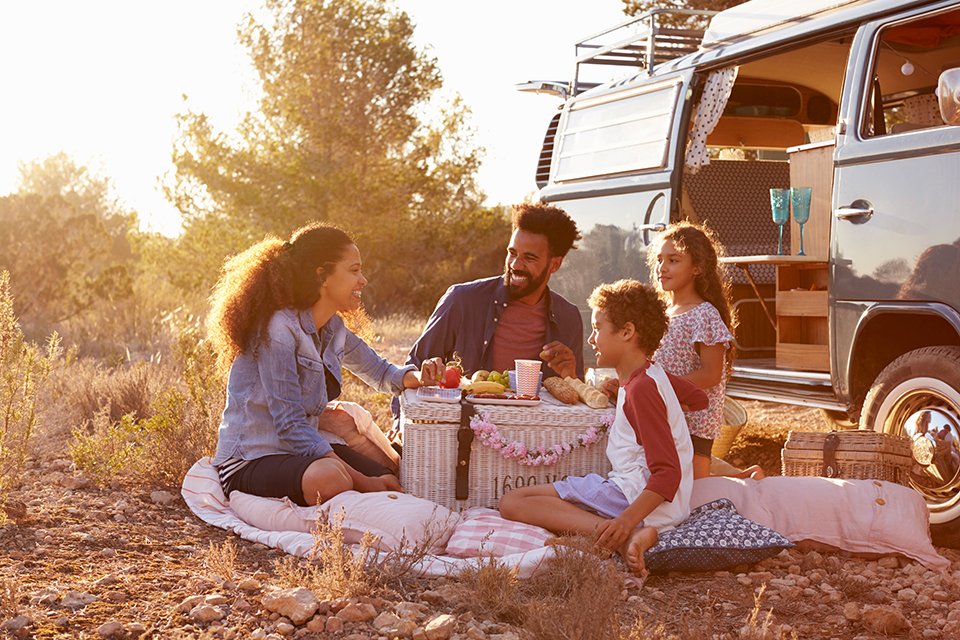
Camping is one trip that it’s easy to overpack for, but you want to avoid taking too much. Between making sure you have enough clothes and loading up on-road snacks, it’s easy to fill the space quickly.
Check the weather forecast:
Look at your favorite weather app on your phone to find out the weather of where you’re headed. While a chill can land in the desert overnight, use the info from the forecast before packing a third sweatshirt.
Prepare for the family:
Start with a checklist to know what you’ll need for your whole family for the duration of the trip. If you’re bringing young children, it can be especially important to weigh needs (clothes, pillow, favorite stuffed animal) against wants (screens, battery-operated toys, every stuffed animal).
Extra equipment:
Consider what cooking equipment is available at the site and what you need. For rustic camping, coolers and portable stoves that fit in the trunk of your vehicle are often the way to go. RVs and tent trailers are more likely to have an attached stove and small cooling space (like a fridge or cooler), but coolers are still helpful for bringing water and anything else that won’t fit in the inherently limited storage space. Most importantly, don’t forget the marshmallow pokers!
Finally, remember that even experienced campers will likely forget things now and again. Know where to find the nearest stores to your campsite to procure backup materials in a pinch. Firewood and ice for coolers will inevitably need to be refilled throughout your trip, but most campgrounds have small stores that offer these.
Where to Camp in Texas
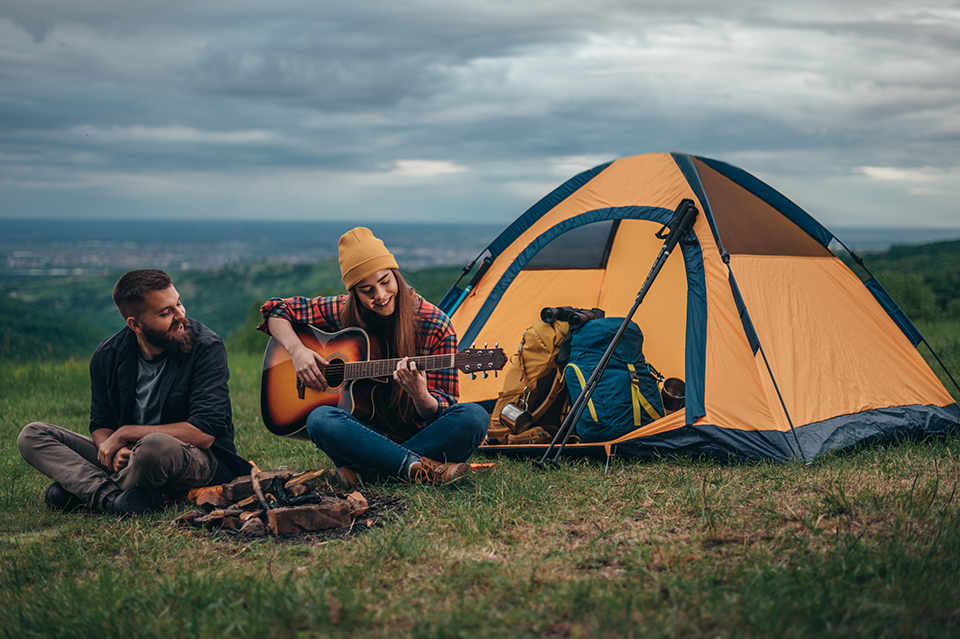
No matter where you live in Texas, there is no shortage of great spots to set up camp. In fact, you can reach many Texas State Parks in less than an hour’s drive from home. Whether you’re vacationing on a budget or simply looking for a nearby weekend trip, the opportunity to get out into nature is always close at hand.
When deciding on a location, you’ll first want to consider what type of campground you prefer to visit. State parks are generally safe and affordable, offering easy access to hiking trails and other attractions. However, if you find the right private campground, these locations often boast other amenities like heated pools, clubhouses, or cornhole pits. KOA locations are perhaps some of the best-known privately owned campgrounds.
Just like with hotels or Airbnb stays, check online reviews and sites like Tripadvisor to learn more about a location before you book. Wherever you are hoping to stay, the business’ website will likely let you pre-book your stay and verify accommodations.
Camping Near the Gulf Coast
Houstonians can count on a relatively temperate climate, thanks to the city’s close distance to the Gulf of Mexico. That type of weather makes the summer a great time to visit coastal campgrounds and hit the beach. These are some of Patten Title’s top picks for camping in the Houston area.
Brazos Bend State Park:
If you’re a fan of hiking, Brazos Bend State Park offers 37 miles of trails. Visiting this state park is also a fantastic way to see the stars; the George Observatory, a part of the Houston Museum of Natural Science, is located within park boundaries and offers a special stargazing event on Saturday nights.
Campers can reserve a campsite, cabin, or screened shelter to stay for the weekend. Campsites start as low as $12 for families who prefer rustic camping, or $25 to include electricity. Reservations are required, and the spots for cabin camping fill quickly.
Galveston Island State Park:
Visitors to Galveston Island State Park can enjoy the Texas coast with swimming, fishing, hiking, and bird watching all within the state park. The park hosts regular events perfect for groups and families.
Campers enjoy campsites or lodges located right on the beach or by the bay. Cost ranges from $15 to camp in a tent to $200 to stay in a lodge.
Galveston Island KOA Holiday:
Looking to visit Galveston Island in style? The Galveston Island KOA offers RV and Deluxe Cabin rentals at a location near the beach. This campground has it all in terms of amenities, with Wi-Fi, beach access, a hot tub and lazy river, and more.
Lake Livingston State Park:
Lake Livingston State Park, located north of Houston, welcomes visitors who enjoy swimming, fishing, and kayaking. The State Park even rents double kayaks through an online service called Paddle EZ.
Tent campers can book sites with water access, and RV campers have full hookups. The state park also has 10 screened shelters that fit up to eight adults. Some shelters are ADA and wheelchair accessible.
Splashway Campground:
The Splashway Waterpark and Campground is the glamping experience of a lifetime. Splashway is a full waterpark with an abundance of eateries, such as Tortuga’s Tacos & Cantina and Coasts & Oaks Coffee Bar with promises of fun for the whole family.
The campground offers “every style” of campsite available, from tent sites to RV parking to cozy cottage rentals. Cost to camp ranges from $45-$199 per night.
Huntsville State Park:
The Huntsville State Park is fixed within the Sam Houston National Forest and is a great place to immerse in nature amongst the tall pine trees. Visitors can fish, swim, or kayak on Lake Raven.
There are more than 160 campsites ranging from tent camping to RV hookups. Huntsville State Park also boasts 28 screened shelters that can fit eight adults.
Lake Houston Wilderness Park:
The Lake Houston Wilderness Park is a part of the Houston Parks and Recreation Department and encompasses almost 5,000 acres of forested area. In addition to more than 20 miles of trails to explore, fishing and kayaking are encouraged while camping.
Lake Houston Wilderness Park offers standard campsites with fire rings and picnic tables for as little as $7 per night. Cabins are also available and range from small and rustic to large with electricity and restrooms.
Camping in Central Texas
Austin may be the Live Music Capital of the World, but there’s more to the area than festivals and concerts. Weekend adventurers can find 18 state parks located as close as 10 miles away from downtown Austin.
McKinney Falls State Park:
Hike and bike the trails, or go for a swim at one of two locations within McKinney Falls State Park. The park also hosts regular events, such as line dancing classes or art in the park.
After a day in the park, you can set up a tent for as little as $20 per night, and all campsites boast electrical hookups. For a little more luxury, rent a four-person cabin that includes an A/C unit for $86.
Yogi Bear’s Jellystone Park:
The Jellystone Parks franchises are a staple for families that love to camp. The park in Canyon Lake includes splash pads for the little ones, laser tag for the teens, plus tubing, mini golf, regular arts and crafts events, and many more attractions.
Stays vary from rustic camping to cabins that are pet friendly. Rates vary throughout the season, and deals or sales are often available.
Bastrop State Park:
Bastrop State Park is located in the “Lost Pines,” a unique ecosystem that is protected by state parks. In 2011, much of the park was damaged by wildfires, but it remains a beautiful location to visit. There are seven miles of hiking trails available at this state park. For those who prefer to sit back and relax, scenic Park Road 1C allows visitors to view both recovering and forested areas on the move.
Enjoy a fully rustic experience or pull an RV into one of the 35 full hookup spaces. The park also has 14 cabins that range in size and luxury amenities.
Krause Springs:
Krause Springs is located just west of Austin, and visitors can find 32 natural springs on the property as well as a man-made pool for swimming. To enjoy the springs without camping, you can purchase a day pass to see the area.
The location has been privately owned by the Krause Family for more than 50 years and offers both primitive tent camping and RV sites.
Austin East KOA:
Located within the bounds of the city, the Austin East KOA makes for a quick getaway to spend time with the family. Like other KOA locations, this campground boasts amenities such as a pool, playground, and even a dog park.
Cabin campers enjoy cable TV and beds with clean linen. Tent campers can choose with or without water access.
Pedernales Falls State Park:
Pedernales Falls State Park visitors enjoy nature by hiking, swimming, and biking. Whether you’re an experienced hiker looking to take on the six-mile Wolf Mountain Trail or you’re more interested in a short, scenic walk to the falls, this park has it.
The park has two options for tent campers: a primitive option that is a two-mile hike from the parking area or one with electricity and a close shower. Pedernales Falls also has a group camp for visitors bringing their horses.
COTA Camping:
Fans of Circuit of the Americas will enjoy camping at COTA for a chance to stay right near the action. Even when there are no motorsports events, there’s no shortage of excitement. The Germania Insurance Amphitheater is Austin’s largest outdoor amphitheater and hosts concerts all summer long.
COTA Camping is a full-service RV park with a gated pool, children’s playground, and a full-service store.

